Active August 1914–1920 | Founded 1914 | |
 | ||
Size 619,646 enlistments during existence Similar Canadian Corps, Canadian Army, Canadian Militia, Canadian Armed Forces, Canadian Expeditionary Force Co | ||
The last reunion of the canadian expeditionary force
The Canadian Expeditionary Force (CEF) was the designation of the field force created by Canada for service overseas in the First World War. The force fielded several combat formations on the Western Front in France and Belgium, the largest of which was the Canadian Corps, consisting of four divisions. The Canadian Cavalry Brigade and the Canadian Independent Force, which were independent of the Canadian Corps, also fought on the Western Front. The CEF also had a large reserve and training organization in England, and a recruiting organization in Canada. In the later stages of the European war, particularly after their success at Vimy Ridge and Passchendaele, the Canadian Corps was regarded by friend and foe alike as the most effective Allied military formation on the Western Front. The Germans went so far as to call them "storm troopers" for their great combat efficiency. In August 1918, the CEF's Canadian Siberian Expeditionary Force travelled to revolution-rift Russia. It reinforced an anti-Bolshevik garrison in Vladivostok during the winter of 1918–19. At this time, another force of Canadian soldiers were placed in Archangel, where they fought against Bolsheviks.
Contents
- The last reunion of the canadian expeditionary force
- Composition
- The Battle of Ypres 1915
- The Battle of the Somme JulyNovember 1916
- The Battle of Vimy Ridge 912 April 1917
- Passchendaele October November 1917
- The final count
- The end of the CEF
- Animals
- Vehicles
- Small arms
- Uniforms load bearing and protective equipment
- Labour
- References
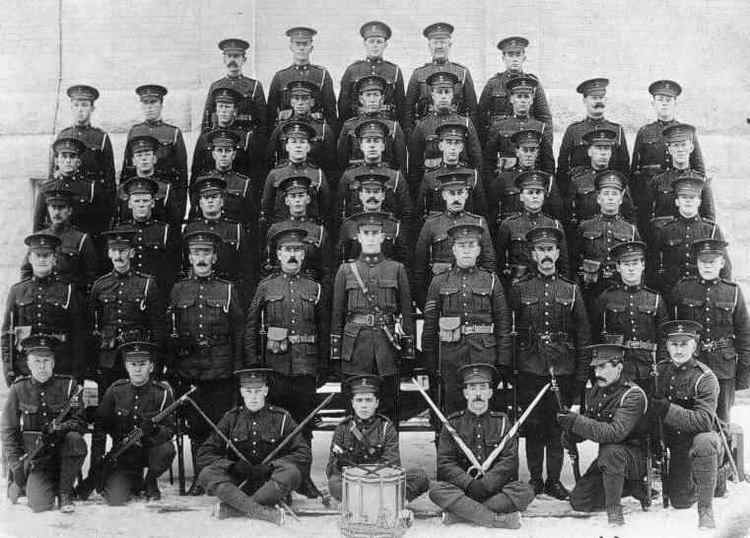
Composition
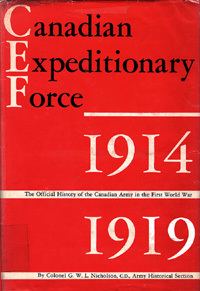
The Canadian Expeditionary Force was mostly volunteers, as conscription was not enforced until the end of the war when call-ups began in January 1918 (see Conscription Crisis of 1917). Ultimately, only 24,132 conscripts arrived in France before the end of the war.
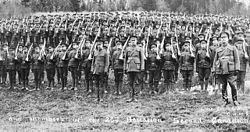
Canada was the senior Dominion in the British Empire and automatically at war with Germany upon the British declaration. According to Canadian historian Dr. Serge Durflinger at the Canadian War Museum, popular support for the war was found mainly in English Canada. Of the first contingent formed at Valcartier, Quebec in 1914, 'fully two-thirds were men born in the United Kingdom'. By the end of the war in 1918, at least 'fifty per cent of the CEF consisted of British-born men'. Recruiting was difficult among the French-Canadian population, although one battalion, the 22nd, who came to be known as the 'Van Doos', was French-speaking ("Van Doos" is an approximate pronunciation of the French for "22nd" - vingt-deuxième)
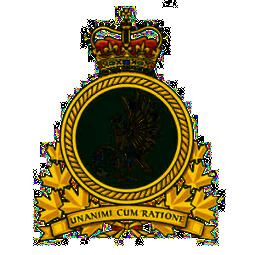
To a lesser extent, several other cultural groups within the Dominion enlisted and made a significant contribution to the Force including Indigenous people of the First Nations, Black Canadians as well as Black Americans. Many British nationals from the United Kingdom or other territories who were resident in Canada also joined the CEF. A sizeable percentage of Bermuda's volunteers who served in the war joined the CEF, either because they were resident in Canada already, or because Canada was the easiest other part of the Empire and Commonwealth to reach from Bermuda (1,239 kilometres (770 miles) from Nova Scotia). As several CEF battalions were posted to the Bermuda Garrison before proceeding to France, islanders were also able to enlist there. Although the Bermuda Militia Artillery and Bermuda Volunteer Rifle Corps both sent contingents to the Western Front, the first would not arrive there 'til June 1915. By then, many Bermudians had already been serving on the Western Front in the CEF for months. Bermudians in the CEF enlisted under the same terms as Canadians, and all male British Nationals resident in Canada became liable for conscription under the Military Service Act, 1917.
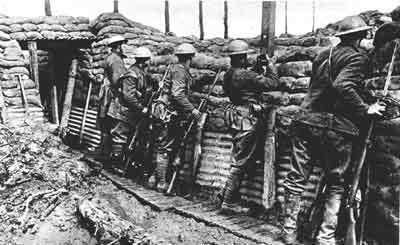
The CEF raised 260 numbered infantry battalions, two named infantry battalions (The Royal Canadian Regiment and Princess Patricia's Canadian Light Infantry), 13 mounted rifle regiments, 13 railway troop battalions, 5 pioneer battalions, four divisional supply trains, four divisional signals companies, a dozen engineering companies, over 80 field and heavy artillery batteries, fifteen field ambulance units, 23 general and stationary hospitals, and many other medical, dental, forestry, labour, tunnelling, cyclist, and service units. Two tank battalions were raised in 1918 but did not see service. Most of the infantry battalions were broken up and used as reinforcements, with a total of fifty being used in the field, including the mounted rifle units, which were re-organized as infantry. The artillery and engineering units underwent significant re-organization as the war progressed, in keeping with rapidly changing technological and tactical requirements.
A distinct entity within the Canadian Expeditionary Force was the Canadian Machine Gun Corps. It consisted of several motor machine gun battalions, the Eatons, Yukon, and Borden Motor Machine Gun Batteries, and nineteen machine gun companies. During the summer of 1918, these units were consolidated into four machine gun battalions, one being attached to each of the four divisions in the Canadian Corps.
The Canadian Corps with its four infantry divisions comprised the main fighting force of the CEF. The Canadian Cavalry Brigade also served in France. Support units of the CEF included the Canadian Railway Troops, which served on the Western Front and provided a bridging unit for the Middle East; the Canadian Forestry Corps, which felled timber in Britain and France, and special units which operated around the Caspian Sea, in northern Russia and eastern Siberia.
The Battle of Ypres, 1915
The 1915 Battle of Ypres, the first engagement of Canadian forces in the Great War, changed the Canadian perspective on war. Ypres exposed Canadian soldiers and their commanders to modern war. They had already experienced the effects of shellfire and developed a reputation for aggressive trench raiding despite their lack of formal training and generally inferior equipment. They were equipped with the frequently malfunctioning Ross rifle, the older, lighter and less reliable Colt machine gun and an inferior Canadian copy of British webbing equipment that rotted quickly and fell apart in the wet of the trenches. In April 1915, they were introduced to yet another facet of modern war, gas. The Germans employed chlorine gas to create a hole in the French lines adjacent to the Canadian force and poured troops into the gap. The Canadians, operating for the most part in small groups and under local commanders, fired into the flanks of the German advance, forcing it to turn its attention onto the Canadian sector. For three days, Canadian and reinforcing British units fought to contain the penetration with a series of confused and suicidally brave counter-attacks while using handkerchiefs soaked in urine to neutralize effects of the gas. What the Canadians lacked in expertise, they made up for in sheer guts and determination. One in every three of them became a casualty. The senior Canadian officers did not exactly shine during this time; they were inexperienced and lacked communications with most of their troops, but they learned. Notable among these was Arthur Currie, a brigade commander who was later to become the commander of the Canadian Corps and who was to appoint as his divisional commanders only those who had fought well in this engagement. The battle cost the British Expeditionary Force - BEF (of which the Canadian Corps was a part of) 59, 275 men and the Canadian Expeditionary Force over 6000. The Canadians developed a great respect for gas and over the duration of the war, they became particularly adept in its use.
The Battle of the Somme, July–November 1916
"The Somme offensive had no great geographical objectives. Its purpose was threefold – to relieve pressure on the French armies at Verdun, to inflict as heavy losses as possible on the German armies, and to aid allies on other fronts by preventing any further transfer of German troops from the west." The Canadian Corps was formed after receiving the 2nd and 3rd and later, 4th divisions. Its first commander was Lieutenant-General Edwin Alderson, who was soon replaced by Lieutenant-General Julian Byng, just in time to repulse a German attack at Mont Sorrel in the Ypres sector in June 1916 as much of the BEF was moving toward the Somme. In this engagement, Major-General Malcolm Mercer, commander of the newly formed 3rd Division was killed, becoming the most senior Canadian to be killed in the war. The corps did not participate in the battles of the Somme until September, but it opened on 1 July after a seven-day bombardment. British losses on the first day amounted to 57,470, which included the casualties of the Newfoundland Regiment serving in the British 29th Division. The regiment was annihilated when it attacked at Beaumont Hamel. By the time the four Canadian divisions of the corps participated in September, the Mark I Tank first appeared in battle. Few were available, but the production time for such unfamiliar and unproven technology ensured that greater numbers were not to be available for some time, so they were committed in order to aid the expected breakthrough. The psychological impact of them was astounding, and the legend was created that they made many German soldiers surrender immediately, although the four months of sustained combat, high casualties among the defending Germans and the appearance of the fresh Canadian Corps were more likely factors in the increasing surrenders. The toll of the five-month campaign cannot be statistically verified by a single reliable source however historians have come into the range of German losses roughly 670,000 and an Allied total of 623,907. The Canadian Corps suffered almost 25,000 casualties in this the final phase of the operation, but like the remainder of the BEF, it had developed, at great cost, significant experience in the use of infantry and artillery and in tactical doctrine, preparation and leadership under fire.
The Battle of Vimy Ridge, 9–12 April 1917
The Battle of Vimy Ridge had incredible significance for Canada as a young nation. For the first time ever the Canadian Corps, with all four of its divisions attacked as one, under Canadian leadership with sole members from Canada. This tactical victory clearly showed how effective and powerful the Canadian Expeditionary Forces had become. This single Canadian offensive amounted to the capture of more land, prisoners and armaments than any previous offensive. The main offensive tactic was the creeping barrage, an artillery strike combined with constant infantry progression through the battlefield.
Passchendaele, October – November 1917
In August 1917, the Canadian Corps attacked Lens as a distraction to allow two armies of the BEF to begin the Third Battle of Ypres, the attack on Passchendaele Ridge. The Corps, led by Lieutenant General Arthur Currie, captured Hill 70 overlooking Lens and forced the Germas to launch more than twenty counter-attacks in attempting to remove the threat to its flank. The Ypres offensive began well with the lightening Vimy-like capture of the Messiness Ridge, but weather, concrete defences and the lack of any other allied effort meant that the BEF fought a muddy, bloody campaign against the main German force for two months. The BEF, including the ANZACs, pushed to within two kilometres of the objective with very high casualties and in ever-deepening mud. By September, it became obvious that either the offensive be ended or a fresh force brought in for the final push. With the situation in Italy and within the French army deteriorating, it was decided to continue the push and Currie was ordered to bring in the Canadian Corps. He insisted on time to prepare, on reorganizing the now-worn down artillery assets and on being placed under command of General Plumer, a commander he trusted. The first assault began on October 26, 1917. It was designed to achieve about 500 meters in what had become known as "bite and hold" tactics but at great cost, 2,481 casualties. and made little progress. The second assault on October 30 cost another 1,321 soldiers and achieved another 500 metres but reached the high ground at Crest Farm. On November 6, after another round of preparations, a third attack won the town of Passchendaele, for another 2,238 killed or wounded and the final assault to capture the remainder of Passchendaele Ridge began on November 10 and was completed the same day. Nine Canadians earned the Victoria Cross in an area not much bigger than four football fields and the Canadian Corps completed the operation, which had taken the BEF three months to advance the eight kilometres onto the ridge. Canadian Corps suffered 15,654 battle casualties in the muddiest, most iconic battle of the Great War.
The final count
After distinguishing themselves in battle from the Second Battle of Ypres, through the Somme and particularly in the Battle of Arras at Vimy Ridge in April 1917, and Passchendaele the Canadian Corps came to be regarded as an exceptional force by both Allied and German military commanders. Since they were mostly unmolested by the German army's offensive manoeuvres in the spring of 1918, the Canadians were ordered to spearhead the last campaigns of the War from the Battle of Amiens on August 8, 1918, which ended in a tacit victory for the Allies when the armistice was signed on November 11, 1918.
The Canadian Expeditionary Force lost 60,661 men killed or died during the war, representing 9.28% of the 619,636 who enlisted.
The end of the CEF
The CEF was a special force, distinct from the Canadian Militia which mobilized in 1914 on a limited basis for home defence and to assist with the recruitment and training of the CEF. In 1918 the militia personnel active in Canada were granted CEF status, to simplify administration in the wake of conscription coming into force. Beginning in 1918, in anticipation of the disbandment of the CEF, plans for the re-organization of the militia were initiated, guided largely by the deliberations of the Otter Commission, convened for this purpose. Among the commission's recommendations was a plan by which individual units of the Canadian Militia, notably infantry and cavalry regiments, would be permitted to perpetuate the battle honours and histories of the CEF units that had fought during the war.
During the latter part of the war, the Canadian Military Hospitals Commission reported on provision of employment for members of the Canadian Expeditionary Force on their return to Canada, and the re-education of those who were unable to follow their previous occupations because of disability.
Animals
Officially an infantry division would be classified at full animal strength at 5,241 horses and mules, 60.7 percent or 3,182 of these animals were part of the infantry division's artillery branch.
Besides mounted and cavalry units, the CEF used horses, mules, donkeys and cattle to transport gun pieces on the battle front as motorised vehicles would not be able to handle rough terrain.
At the start of the war over 7000 horses were brought over to England and Europe from Canada and by the end of the war over 8 million horses were lost in the course of fighting in Europe.
Dogs and carrier pigeons were employed as messengers in the front.
With horses, wagons were also used to transport equipment as well.
Vehicles
Small arms
.303 rifles
Uniforms, load bearing and protective equipment
See also: Battledress, Uniforms of the Canadian Forces
Load bearing equipment
Head dress
Labour
Chinese labourers were also brought over to Europe, especially the Canadian Railway Troops. From 1917 to 1918 84,000 Chinese labourers were acquired for the Chinese Labour Corps from China (via Shandong Province) that were shipped to Canada and then some the Western Front. Many of these labourers died in Belgium and France.
